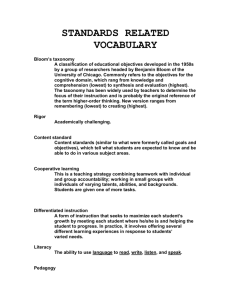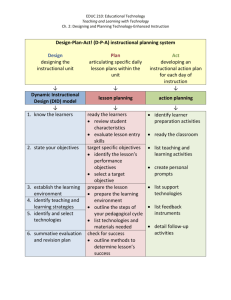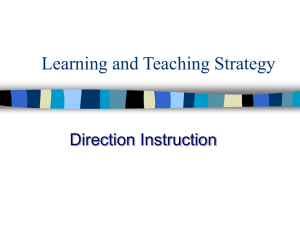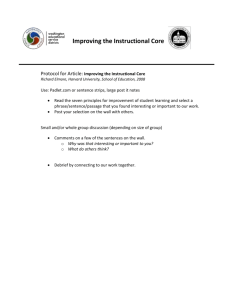Implementing a Strategic, Sequential, and Iterative Learning
advertisement
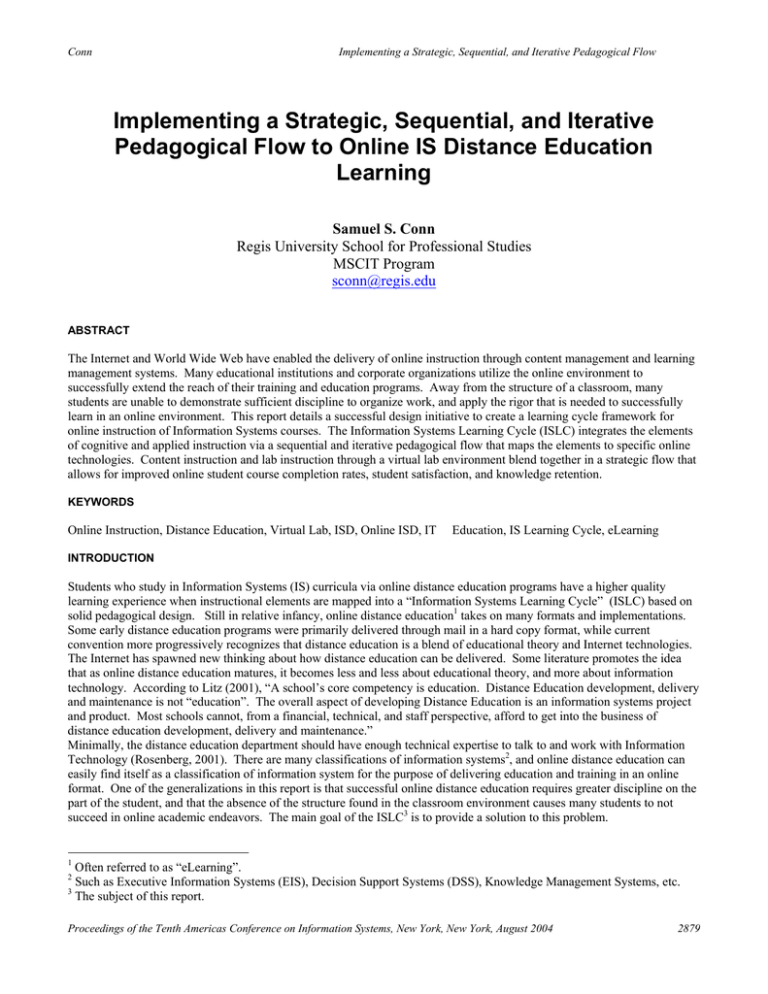
Conn Implementing a Strategic, Sequential, and Iterative Pedagogical Flow Implementing a Strategic, Sequential, and Iterative Pedagogical Flow to Online IS Distance Education Learning Samuel S. Conn Regis University School for Professional Studies MSCIT Program sconn@regis.edu ABSTRACT The Internet and World Wide Web have enabled the delivery of online instruction through content management and learning management systems. Many educational institutions and corporate organizations utilize the online environment to successfully extend the reach of their training and education programs. Away from the structure of a classroom, many students are unable to demonstrate sufficient discipline to organize work, and apply the rigor that is needed to successfully learn in an online environment. This report details a successful design initiative to create a learning cycle framework for online instruction of Information Systems courses. The Information Systems Learning Cycle (ISLC) integrates the elements of cognitive and applied instruction via a sequential and iterative pedagogical flow that maps the elements to specific online technologies. Content instruction and lab instruction through a virtual lab environment blend together in a strategic flow that allows for improved online student course completion rates, student satisfaction, and knowledge retention. KEYWORDS Online Instruction, Distance Education, Virtual Lab, ISD, Online ISD, IT Education, IS Learning Cycle, eLearning INTRODUCTION Students who study in Information Systems (IS) curricula via online distance education programs have a higher quality learning experience when instructional elements are mapped into a “Information Systems Learning Cycle” (ISLC) based on solid pedagogical design. Still in relative infancy, online distance education1 takes on many formats and implementations. Some early distance education programs were primarily delivered through mail in a hard copy format, while current convention more progressively recognizes that distance education is a blend of educational theory and Internet technologies. The Internet has spawned new thinking about how distance education can be delivered. Some literature promotes the idea that as online distance education matures, it becomes less and less about educational theory, and more about information technology. According to Litz (2001), “A school’s core competency is education. Distance Education development, delivery and maintenance is not “education”. The overall aspect of developing Distance Education is an information systems project and product. Most schools cannot, from a financial, technical, and staff perspective, afford to get into the business of distance education development, delivery and maintenance.” Minimally, the distance education department should have enough technical expertise to talk to and work with Information Technology (Rosenberg, 2001). There are many classifications of information systems2, and online distance education can easily find itself as a classification of information system for the purpose of delivering education and training in an online format. One of the generalizations in this report is that successful online distance education requires greater discipline on the part of the student, and that the absence of the structure found in the classroom environment causes many students to not succeed in online academic endeavors. The main goal of the ISLC3 is to provide a solution to this problem. 1 Often referred to as “eLearning”. Such as Executive Information Systems (EIS), Decision Support Systems (DSS), Knowledge Management Systems, etc. 3 The subject of this report. 2 Proceedings of the Tenth Americas Conference on Information Systems, New York, New York, August 2004 2879 Conn Implementing a Strategic, Sequential, and Iterative Pedagogical Flow This design methodology also creates a “franchise-able” model4, or framework for information systems curricula. It is ideally suited for collaborative programs, and joint degree programs between partner colleges and universities. Besides currently being implemented in an information systems graduate program with several hundred students in the United States, the ISLC is the foundation for a joint degree program between an American university and a European university. By following the ISLC framework, both institutions can offer a program of instruction in Information Systems that is cohesive, uniform, and of high quality, even though program offerings, development methodologies, and pedagogical approach are very distinct to each institution. Online delivery of IS curricula, as indicated by the research of this report, has seen immediate scores indicating higher student satisfaction and higher learning outcomes as a result of the design. Thinking more strategically about learning means embracing a wider variety of eLearning and other solutions that can be used to solve a performance problem, many of which are not instructional at all (Rosenberg, 2001). It is clear from the outcomes of this report that online learning has a huge reliance on Information Systems methods and technologies, and that expertise and experience in designing an Information System is a critical skill in developing and implementing online distance education. ISSUES ASSOCIATED TO STUDENT LEARNING IN IS DISTANCE EDUCATION PROGRAMS Online learning, especially where there is a need to provide a laboratory environment, can result in poor outcomes when Instructional System Design (ISD) is not modified to accommodate a proactive pedagogical approach. Proactive learning with context supported by experiential learning best accommodates the adult learner (Knowles, 1990). Students essentially spend much of the initial time in the course “learning how to learn”. This means that students must learn how to navigate the content or learning management system, discover how to research and gather content, discover how to apply the course content, find a method to reinforce their learning, and then discover how they are evaluated against the content. The time required to do this for each and every course takes much time away from the student with respect to learning the content. In many IS courses, a lab component is involved and if the student must install software locally, then the latency in the course is extended further. The student may also be faced with constraints of low bandwidth, lack of personal organization, unfamiliarity with the content or learning management system being used by the institution, and other related learning inhibitors. There is a certain feeling on the part of students in this situation that they must “push” through the ISD of the course. For this reason, many students are unsuccessful in following the ISD, and in so doing develop frustration in the learning process and exit the course. According to Rosenberg (2001), what we are beginning to note most about eLearning is its growing diversity, beyond courseware and instruction, to generating and disseminating information and directly supporting student performance. Higher persistence is achieved through a supportive ISLC that “pulls” the student rather than “pushes” them. The characteristics of a “pull” design in the ISLC are a strategic flow of content and activities, a sequential flow of serial and parallel pedagogies, and an iterative construct that allows for assessment against outcomes and which validates the student’s learning. The alternative to this is what many students experience in IS distance education programs. They experience issues with poor or absent flow of content and learning activities, a lack of proper sequencing in the various pedagogies employed, no current feedback on performance or outcomes, and no validation of their learning. FOUNDATION FOR INSTRUCTIONAL METHODS The foundation for the instructional methods is composed of three principle drivers. These drivers are the attainment of “experiential consistency” between onsite and online education, the use of Bloom’s5 hierarchy of learning in the Cognitive Domain, and the ALA6 Information Literacy Standards for Information Technology. Additionally, Human Performance Technology factors such as the use of linear sequential and branch tasks7, and other attributes of performance-centered systems, are foundational concepts for the ISLC. Experiential consistency requires that students in the classroom have the same education experience as students online. This is perhaps one of the most difficult challenges in online education and one where information systems and technology may provide a solution. Learners make sense of educational events in what is referred to as a constructivist method (Duffy and Jonassen, 1991; Merrill, 1991). The concept of an Experiential Learning Cycle is noted in the seminal work by David Kolb (1984) when he provided a four stage model for learning from experiences. Kolb (2001) argues that effective learning entails the possession of four different abilities: concrete experience 4 Meaning one that lends itself to cooperative development and joint programs of instruction between two or more participating institutions. 5 Benjamin Bloom (1913-1999) was a teacher and leading educational theorist who developed the concept of taxonomies and hierarchies of learning. Bloom’s Taxonomy defines three “domains”, the Cognitive Domain, the Psychomotor Domain, and the Affective Domain. 6 American Library Association 7 Such as those noted by Gery (1995) Proceedings of the Tenth Americas Conference on Information Systems, New York, New York, August 2004 2880 Conn Implementing a Strategic, Sequential, and Iterative Pedagogical Flow abilities, reflective observation abilities, abstract conceptualization abilities and active experimentation abilities. The activities of the classroom experience are something that must be replicated in the online environment for knowledge transfer to take place. Kolb’s (1984) simple model uses two principle tensions and expresses them as orthogonal dimensions. The “perceptive” dimension represents both concrete and abstract thinking, and the “processing” dimension represents active and reflective information processing. Thus tension between the two dimensions results in learning, where experiences and actions lead to a process of reflection about the action. This reflection leads to generalizations and conceptualizations, which leads to testing. Natural synergy in the process leads the students to start to apply the knowledge in new situations, which leads to experiences and tasks. Thus the concept of the experiential learning cycle is validated. Figure 1 illustrates how achievement of classroom and online experiential consistency is achieved through Kolb’s (1984) constructivist epistemology. An overlay of the experiential learning cycle on to Bloom’s (1956) hierarchy in the cognitive domain illustrates that advancing up the hierarchy is readily achievable by iterations through an experiential learning cycle. This does not generally occur in a structured framework because learners do not qualify their learning through specifically stated objectives. Moreover, as specifically stated objectives are applied to the framework (so that testing supports the learning objectives), then the iteration of the experiential learning cycle is well defined. Once it is well defined in an ISD, then technology and pedagogical influence can create experiential consistency8 between onsite and online learning environments. Figure 1: Equivalency in Onsite and Online Educational Delivery One of the key deliverables for both the onsite learning and the online learning is to have solid educational documentation that forms the foundation for both environments. This can take the form of a course module, course guide, or expanded syllabus that defines the learning objectives, grading rubrics, and specifies certain methodologies to be employed. This ensures integrity in the course foundation for both environments. The real challenge is in the delivery of the instruction, and finding an online design that brings equivalency between the classroom experience and the online experience. Information Systems offers a unique perspective in that online education requires a somewhat complex technology infrastructure for proper delivery. The lack of advancement in ISD is largely caused by the lack of Information System technology integration with the design. A proper merger of the two domains9 results in the ability to advance the ISD with scalable infrastructure architecture, and build models of instruction that improve the learners experience with subsequent revisions. The strategic, sequential, and iterative design of the model presented herein can transparently map to and integrate instructional technology platforms. An example of this is the integration of the content management system platform10 with a virtual lab environment11. BASING INSTRUCTIONAL METHODS ON BLOOM’S HIERARCHY OF LEARNING Bloom’s hierarchy of cognitive development offers an excellent opportunity to map pedagogical methods to the experiential learning cycle. Levels of achievement in cognitive development, based on Bloom’s hierarch, generally indicate that undergraduate curriculum strives to take the student from memorization to analysis. The achievement by the student of the ability to apply and analyze content learned is a worthy objective in undergraduate IS education. In graduate IS education 8 Note Figure 1 Meaning Instructional System Design and Information Systems/Technology 10 In this case WebCT 11 In this case a Citrix portal for course software and applications 9 Proceedings of the Tenth Americas Conference on Information Systems, New York, New York, August 2004 2881 Conn Implementing a Strategic, Sequential, and Iterative Pedagogical Flow students need to pick up at the analysis level12 and learn to synthesize and evaluate content. Unless the student is engaged in an active experiential learning cycle, there are no iterations of learning where advancement up the hierarchy of the cognitive domain can take place and be measured. Figure 2 illustrates the level of achievement typically associated with undergraduate IS education and the higher level of achievement typically associated with graduate IS education. Higher cognitive achievement based on Bloom’s hierarchy in the cognitive domain is a key driver in the ISD of the strategic, sequential, and iterative ISLC. Figure 2: Bloom’s Hierarchy of Learning in the Cognitive Domain The ALA Information Literacy Standards are a final key driver in the design of the learning cycle. Notably, one of the characteristics of the 21st Century Knowledge Worker13 is the ability to search and find quality information. Even with the advent of the Semantic Web, information retrieval is mostly done through search engines and metadata search engines. There are no controls for any standards of authority for information retrieved from the Web. So a key skill for IS students is the ability to retrieve information that is authoritative, credible, and reliable. The ALA Information Literacy Standards for Information Technology provide a framework for guiding students in this direction. The research component of the learning cycle is designed to employ the skills required to meet the Information Literacy Standards, and thus engage the learner with the Web as a primary information system. The integration of the Web into the learning cycle as an information system is an important component to the ISD. ONLINE COURSE DEVELOPMENT FRAMEWORK AND METHODOLOGY Development of the online course begins with a solid road map for the course of instruction. Rosenberg (2001) points out that it is important to base your learning architecture design on the competencies you wish to build. Conducting a thorough needs assessment and translating them into learning objectives is important. This process is used in the development of the ISLC objectives. Using the course module, curriculum guide, or expanded syllabus as the “source” document, the next step is to create a template for movement of content to the instructional designer or developer. There are three primary roles in the process of developing an online IS course. The curriculum and instruction manager for the department provides oversight, direction, content quality assurance, and process management. The subject matter expert (SME) is the content developer who produces the course content organized in template form. And the instructional designer or developer places the content in the content management system, ensures compliance with Section 508 guidelines14, and ensures compliance with the ISLC model. Team interaction between these three roles is essential for the process model to show production. The curriculum and instruction manager works with the instructional designer to develop the initial template so that the elements 12 With the ability to memorize, comprehend, apply, and analyze as given pre-requisites And thus an implicit goal of IS students 14 Federal Guidelines for ADA compliance 13 Proceedings of the Tenth Americas Conference on Information Systems, New York, New York, August 2004 2882 Conn Implementing a Strategic, Sequential, and Iterative Pedagogical Flow of instruction are well organized and easily transferred from the SME/content developer to the instructional designer or developer. The collaborative work between them includes quality assurance reviews by the curriculum and instruction manager, feedback to the SME/content developer and the instructional designer or developer, and coordination between the SME/content developer and the instructional designer or developer. Figure 3 illustrates the three roles in the Process Model for Online Course Development and the communication flows between them. Figure 3: Process Model for Online Course Development ONLINE ELEMENTS OF INSTRUCTION FOR INFORMATION SYSTEMS CURRICULA The concept of the ISLC in this research comes from the use of flow diagramming and normalization, which are basic modeling concepts used in Information Systems. Computer Assisted System Engineering15 employs methods for depicting business processes, the flow of data within an organization, and normalization of data elements into relational and objectrelational structures. The elements of online learning are essentially a dataset that can be modeled using CASE methodology16. Business processes become instructional processes, data flows become information flows, and normalized entities become normalized instructional elements. The elements of online instruction for Information Systems curricula include learning outcomes or objectives, reading assignments, review and study of content presentations, topical or extended research, participation in class forum discussions, reinforcement of learning through review questions, application of the learning via laboratory exercises, and validation17 of the learning outcomes through an assessment activity. Learning objectives for the ISLC are stated in terms of criterion referenced objectives according to the specification suggested in Bloom’s taxonomy of objectives18. Specific extended use and application of the hierarchy of learning in Bloom’s cognitive domain is applied in the guidelines for the discussion forum. Reading elements can be textbooks, websites, external pages, assignments from journals, and so forth. Course presentations may or may not include multimedia, but minimally occur as HTML authored pages or Microsoft PowerPoint presentations converted to HTML format. Research assignments are designed to follow the ALA’s Information Literacy Standards for Information Technology and include appropriate information search and retrieval techniques. The forum discussion is an interactive dialogue between the faculty and students that is guided by questions that appropriately drive the escalation of responses toward the higher cognitive levels in the hierarchy of learning within Bloom’s Taxonomy Cognitive Domain. Review questions are faculty developed or taken from the text for the purpose of reinforcing learning of the content. Lab exercises allow the student to apply their learning using appropriate IS tools, applications, or development environments. The final element is an assessment of how well the student met the learning objectives. The assessment is faculty developed and ties strictly to the criterion referenced objectives stated in the objectives element of the ISLC. These eight elements of online instruction represent a comprehensive 15 CASE CASE methodology being the progression of the underlying system that supports the business model through advancement of Business Process Modeling, Data Flow Diagramming, and Entity Relationship Modeling. 17 Or perhaps Quality Assurance 18 Meaning a balance of learning objectives in the cognitive, psychomotor, and affective domains. 16 Proceedings of the Tenth Americas Conference on Information Systems, New York, New York, August 2004 2883 Conn Implementing a Strategic, Sequential, and Iterative Pedagogical Flow pedagogical approach when combined in the ISLC. Specific activities, tools, and resources apply to each element of instruction, and are delivered via some combination of Internet technologies. MAPPING ONLINE ELEMENTS OF INSTRUCTION TO THE ISLC Once the online elements of instruction are established, they are mapped into the learning cycle. The learning cycle provides additional structure and time management to the student by illustrating the ISLC against a “days of the week” schedule. Each week provides the same learning cycle for the student, so “learning how to learn” online is not the focus, but rather the focus is on the course learning objectives and content. The online elements are generated through a template by the SME/content developer and forwarded to the instructional designer or developer. The learning cycle maps the online instructional elements into the parallel “sequences”, which are hot linked to the specific content in the content management system. The student mouse clicks on each element to go to the specific area in the content management system or virtual lab environment19 where they can complete activities associated with the element. Graded elements are differentiated by color from non-graded elements. Figure 4 illustrates how the online instructional elements are mapped (normalized) into the pedagogy process model. Figure 4: Normalization of Online Elements of Instruction to a Pedagogy Process Model THE INFORMATION SYSTEMS CURRICULA ONLINE LEARNING CYCLE (ISLC) Human Performance Technology factors were also used in the design of the ISLC. Newer instructional design models favor a needs analysis at the front end, and formative and summative evaluation techniques (Dick and Carey, 1996; Tripp and Bichelmeyer, 1990). The learning cycle consists of parallel “sequences” of learning activities, as seen in Figure 5. Students start by reviewing the course enabling objectives to define the learning outcomes and requirements for the week. The first of the parallel sequences to start is the reading assignment. Students begin reading the course text material early in the week. This is followed by the sequence of course presentations. Course presentations can occur in the form of hard coded HTML pages, HTML PowerPoint slides, or downloadable materials. Good Instructional System Design should call for a method of content updating that is not cumbersome or latent. Latent content updates in IS online curricula create an unsustainable model. Next, students engage in two parallel sequences while completing the previous two. The research and discussion elements begin to bring together what is learned from the course text reading and the course presentations. Research follows the guidelines of the ALA Information Literacy Standards for Information Technology, and is based on predefined research questions that add scope or context to the course content. The forum discussion uses the facility in the content management system and is the interactive element that publishes thoughts, comments, and discussion about the weekly content. 19 The content management system and the virtual lab are on different backend platforms and integrated through the ISLC. Proceedings of the Tenth Americas Conference on Information Systems, New York, New York, August 2004 2884 Conn Implementing a Strategic, Sequential, and Iterative Pedagogical Flow Discussion is advanced through discussion questions posted in advance. The discussion questions are designed to extend for the duration of the week and drive advancement of the cognitive hierarchy. Students are challenged in iterative dialogue to demonstrate evidence of application, analysis, synthesis, and evaluation of the content. Figure 5: A Strategic, Sequential, and Iterative Pedagogical Process Model Text reading and research then drive written response to content review questions. These can be faculty developed or be assigned from text or other reference material. Research and presentations drive forum discussion. As students are required to demonstrate advancement up the cognitive hierarchy, iterative research is required to accomplish the task. Adding to Kolb’s (1984) constructivist theory is a reliance on “hands-on” learning: a system of learning that mandates learner control and exploration. Associated lab work is the final parallel sequence element and is designed to reinforce learning, teach application of the content, and develop skill sets. The virtual lab element is hot linked to an external portal environment that provides the tools and applications necessary to complete the weekly lab work. Students end the week with an assessment that is based on the stated learning objectives from the first of the week. The assessment measures the degree to which students were able to accomplish the enabling objectives, and serves as a grading criteria and/or a prescriptive diagnostic for remediation of any course content. IMPLEMENTATION RESULTS The ISLC was developed by this author and implemented by the Regis University MSCIT Department in its distance education initiative. This study represents the outcomes of implementing the ISLC in three database technology courses over a one year period. The student populations for the implementation ranged in size from 52-81 students20. Three factors were evaluated in the study: Student Persistence, Overall Student Satisfaction with the course, and Faculty Evaluation. Student persistence was measured as the percentage of students completing the course21. Overall student satisfaction with the course and the evaluation of the faculty are based on percentages translated from an end-of-course survey using a Likert scale. Figure 6 shows the implementation results of phasing-in the ISLC into three courses over an academic year. Sixteen week terms are divided into two eight week terms of instruction. The Spring 2003 first eight week term (8W1) sets the baseline as the point in time where the ISLC was not used. Measurable improvements in the scores for student persistence, overall 20 Spring ’03 8W1 = 76 students, Spring ’03 8W2 = 81 students, Summer ‘03 8W1 = 55 students, Summer ’03 8W2 = 52 students, Fall ’03 8W1 = 61 students, and Fall ’03 8W2 = 64 students. 21 A factor that directly impacts student retention Proceedings of the Tenth Americas Conference on Information Systems, New York, New York, August 2004 2885 Conn Implementing a Strategic, Sequential, and Iterative Pedagogical Flow satisfaction, and faculty evaluations began with the phased implementation of the ISLC in the Spring 2003 second eight week term (8W2) and continued through the 2003 Fall second eight week term (8W2). 100 90 80 70 60 50 40 30 20 10 0 Student Persistence Overall Satisfaction Faculty Evaluations Spring '03 8W1 Summer '03 8W1 Fall '03 8W1 Figure 6: Implementation Results for the 2003-2004 Academic Year (Online Classes) IMPLEMENTATION SITES The initial implementation site for the ISLC was at Regis University22 School for Professional Studies in Denver, Colorado. The MSCIT23 Program offers emphasis areas in Database Technology, System Engineering, Software Engineering, and Information Systems Executive Management. The ISLC was initially implemented through the Instructional System Design of the Database Technologies emphasis in the Database Concepts course. Subsequent phased implementation occurred in the PL/SQL Programming course and the Database Administration course. Continued implementation of the ISLC will be in the Database Architecture and Oracle 9iAS Portal courses. Through a joint degree program venture with the National University of Ireland Galway, the use of the Learning Cycle as a “franchise-able” curricula concept will be tested. Faculties at the National University of Ireland Galway are currently developing courses using the ISLC for implementation in an online Information Systems Program beginning in the Fall of 2004. Students in both the United States and Europe will take coursework with the ISLC instructional design, thus creating an opportunity for further study in cross-cultural environments. SUMMARY AND CONCLUSION The ISLC is designed for Information Systems curricula and incorporates modeling concepts from Information Systems in its design. It also employs concepts from Human Performance Technology factors for eLearning systems. The ISLC is “strategic” because it employs a strategy designed to give specific structure to online learning, deliver experiential consistency between classroom and online instruction, and “pull” rather than “push” students through a course of instruction. It is sequential because it employs techniques to advance a student’s cognitive processes through a series of instructional elements that occur as parallel sequences. And the ISLC is iterative because it is a closed loop. The beginning and ending points for the student’s learning experience is a statement and assessment of objective based learning outcomes. Iterations occur within the Learning Cycle to accomplish advancement of measurable cognitive processes and reinforcement of learning through practical applications. The ISLC can accommodate Instructional System Design based on Learning Objects, and can easily map to SCORM24 compliant structures. Although the Learning Cycle was specifically designed using Information System concepts and constructs for Information System curricula, there is universal applicability to the design. Future areas 22 One of 28 Jesuit Colleges and Universities in the US and is accredited by the North Central Association of Colleges and Schools 23 Master of Science in Computer Information Technology 24 Shareable Courseware Object Reference Model Proceedings of the Tenth Americas Conference on Information Systems, New York, New York, August 2004 2886 Conn Implementing a Strategic, Sequential, and Iterative Pedagogical Flow of research and study, beyond the current cross-cultural initiative with a European university, may be in alternative curriculum areas. The general indications of the implementation results for the 2003-2004 academic year is that the ISLC improves student persistence, and thus retention and completion rates in online IS database courses, overall student satisfaction with the online course of instruction, and an increase in favorable assessment of the faculty. REFERENCES 1. Bloom, B. S. (1956). Taxonomy of Educational Objectives: The Classification of Educational Goals: Handbook I, Cognitive Domain. New York, NY: Addison-Wesley. 2. Dick, W., Carey, L., & Carey, J. O. (2000). The Systematic Design of Instruction (5th ed.). Boston, MA: Pearson Allyn & Bacon. 3. Duffy, T. M., & Jonassen, D. H. (1991). Constructivism: New Implications for Instructional Technology? Educational Technology, 31(5), 7-12. 4. Gery, G. (1995). Attributes and Behaviors of Performance-Centered Systems. Performance Improvement Quarterly, 8(1), 47-93. 5. Knowles, M. (1990). The Adult Learner (4th ed.): Gulf Publishing. 6. Kolb, D. A. (1984). Experiential Learning. Englewood Cliffs, NJ: Prentice Hall. 7. Kolb, A., & Kolb, D. A. (2001). Experiential Learning Theory Bibliography 1971-2001. Boston, MA: McBer and Company. 8. Litz, T. (2003). Regis New Ventures Online Course Research Project. Denver, CO: Information Technology Consultant’s Report. 9. Merrill, M. D., Li, Z., & Jones, M. (1991). Instructional Transaction Theory: An Introduction. Education Technology, 31(6), 7-12. 10. Rosenberg, M. J. (2001). e-Learning Strategies for Delivering Knowledge in the Digital Age. New York, NY: McGrawHill. 11. Tripp, S., & Bichelmeyer, B. (1990). Rapid Prototyping: An Alternative Instructional Design Strategy. Educational Technology Research and Development, 38(1), 31-44. Proceedings of the Tenth Americas Conference on Information Systems, New York, New York, August 2004 2887
